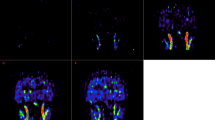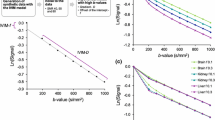Abstract
Purpose
Parametric analysis of 15O-water positron emission tomography (PET) studies allows determination of blood flow (BF), perfusable tissue fraction (PTF), and volume of distribution (V d) with high spatial resolution. In this paper the performance of basis function and linear least squares methods for generating parametric flow data were evaluated.
Procedures
Monte Carlo simulations were performed using typical perfusion values for brain, tumor, and heart. Clinical evaluation was performed using seven cerebral and 10 myocardial 15O-water PET studies. Basis function (BFM), linear least squares (LLS), and generalized linear least squares (GLLS) methods were used to calculate BF, PTF, or V d.
Results
Monte Carlo simulations and human studies showed that, for low BF values (<1 ml/min/ml), BF, PTF, and V d were calculated with accuracies better than 5% for all methods tested. For high BF (>2 ml/min/ml), use of BFM provided more accurate V d compared with (G)LLS.
Conclusions
In general, BFM provided the most accurate estimates of BF, PTF, and V d.







Similar content being viewed by others
References
Ketty SS, Schmidt CF (1948) The nitrous oxide method for the quantitative determination of cerebral blood flow in man: Theory, procedure and normal values. J Clin Invest 27:476–483
Frackowiak RS, Lenzi GL, Jones T, Heather JD (1980) Quantitative measurement of regional cerebral blood flow and oxygen metabolism in man using 15o and positron emission tomography: Theory, procedure, and normal values. J Comput Assist Tomogr 4:727–736
Herscovitch P, Markham J, Raichle ME (1983) Brain blood flow measured with intravenous H2(15)O. I. Theory and error analysis. J Nucl Med 24:782–789
Huang SC, Carson RE, Hoffman EJ, et al. (1983) Quantitative measurement of local cerebral blood flow in humans by positron computed tomography and 15O-water. J Cereb Blood Flow Metab 3:141–153
Lammertsma AA, Frackowiak RS, Hoffman JM, et al. (1989) The C15O2 build-up technique to measure regional cerebral blood flow and volume of distribution of water. J Cereb Blood Flow Metab 9:461–470
Lammertsma AA, Cunningham VJ, Deiber MP et al. (1990) Combination of dynamic and integral methods for generating reproducible functional CBF images. J Cereb Blood Flow Metab 10:675–686
Iida H, Law I, Pakkenberg B, Krarup-Hansen A, et al. (2000) Quantitation of regional cerebral blood flow corrected for partial volume effect using O-15 water and PET. I. Theory, error analysis, and stereologic comparison. J Cereb Blood Flow Metab 20:1237–1251
Hermansen F, Rosen SD, Fath-Ordoubadi F, et al. (1998) Measurement of myocardial blood flow with oxygen-15 labelled water: Comparison of different administration protocols. Eur J Nucl Med 25:751–759
Bergmann SR, Fox KA, Rand AL, et al. (1984) Quantification of regional myocardial blood flow in vivo with H215O. Circulation 70:724–733
Iida H, Rhodes CG, De Silva R, et al. (1991) Myocardial tissue fraction-correction for partial volume effects and measure of tissue viability. J Nucl Med 32:2169–2175
Bacharach SL, Libutti SK, Carrasquillo JA (2000) Measuring tumor blood flow with H(2)(15)O: Practical considerations. Nucl Med Biol 27:671–676
Lammertsma AA, Wise RJ, Jones T, et al. (1983) In vivo measurements of regional cerebral blood flow and blood volume in patients with brain tumours using positron emission tomography. Acta Neurochir 69:5–13
Lodge MA, Carson RE, Carrasquillo JA, Whatley M, Libutti SK, Bacharach SL (2000) Parametric images of blood flow in oncology pet studies using [15O]Water. J Nucl Med 41:1784–1792
Wilson CB, Lammertsma AA, McKenzie CG, Sikora K, Jones T (1992) Measurements of blood flow and exchanging water space in breast tumors using positron emission tomography: A rapid and noninvasive dynamic method. Cancer Res 52:1592–1597
Huang SC, Carson RE, Phelps ME (1982) Measurement of local blood flow and distribution volume with short-lived isotopes: A general input technique. J Cereb Blood Flow Metab 2:99–108
Alpert NM, Eriksson L, Chang JY, et al. (1984) Strategy for the measurement of regional cerebral blood flow using short-lived tracers and emission tomography. J Cereb Blood Flow Metab 4:28–34
Blomqvist G (1984) On the construction of functional maps in positron emission tomography. J Cereb Blood Flow Metab 4:629–632
Carson RE, Huang SC, Green MV (1986) Weighted integration method for local cerebral blood flow measurements with positron emission tomography. J Cereb Blood Flow Metab 6:245–258
Boellaard R, Buijs F, De Jong HWAM, Lenox M, Gremillion T, Lammertsma AA (2003) Characterization of a single LSO crystal layer high resolution research tomograph. Phys Med Biol 48:429–448
Wienhard K, Schmand M, Casey ME, et al. (2002) The ECAT HRRT: Performance and first clinical application of the new high resolution research tomograph. IEEE Trans Nucl Sci 49:104–110
van den Hoff J, Burchert W, Muller-Schauenburg W, Meyer GJ, Hundeshagen H (1993) Accurate local blood flow measurements with dynamic PET: Fast determination of input function delay and dispersion by multilinear minimization. J Nucl Med 34:1770–1777
Alpert NM, Rabito CA, Correia DJ, et al. (2002) Mapping of local renal blood flow with PET and H(2)(15)O. J Nucl Med 43:470–475
Feng DG, Wang ZZ, Huang SC (1993) A study on statistically reliable and computationally efficient algorithms for generating local cerebral blood-flow parametric images with positron emission tomography. IEEE Trans Med Imaging 12:182–188
Chen K, Lawson M, Reiman E, et al. (1998) A generalized linear least squares method for fast generation of myocardial blood flow parametric images with N-13 ammonia PET. IEEE Trans Med Imaging 17:236–243
Gunn RN, Lammertsma AA, Hume SP, Cunningham VJ (1997) Parametric imaging of ligand–receptor binding in PET using a simplified reference region model. NeuroImage 6:279–287
Iida H, Kanno I, Takahashi A, et al. (1988) Measurement of absolute myocardial blood flow with H215O and dynamic positron-emission tomography. Strategy for quantification in relation to the partial-volume effect. Circulation 78:104–115
Araujo LI, Lammertsma AA, Rhodes CG, et al. (1991) Noninvasive quantification of regional myocardial blood flow in coronary artery disease with oxygen-15-labeled carbon dioxide inhalation and positron emission tomography. Circulation 83:875–885
Hoekstra CJ, Stroobants SG, Hoekstra OS, Smit EF, Vansteenkiste JF, Lammertsma AA (2002) Measurement of perfusion in stage IIIA-N2 non-small cell lung cancer using H(2)(15)O and positron emission tomography. Clin Cancer Res 8:2109–2115
Law I, Iida H, Holm S, et al. (2000) Quantitation of regional cerebral blood flow corrected for partial volume effect using O-15 water and PET. II. Normal values and gray matter blood flow response to visual activation. J Cereb Blood Flow Metab 20:1252–1263
Ohta S, Meyer E, Fujita H, Reutens DC, Evans A, Gjedde A (1996) Cerebral [15O]Water clearance in humans determined by PET. I. Theory and normal values. J Cereb Blood Flow Metab 16:765–780
Iida H, Jones T, Miura S (1993) Modeling approach to eliminate the need to separate arterial plasma in oxygen-15 inhalation positron emission tomography. J Nucl Med 34:1333–1340
Meyer E (1989) Simultaneous correction for tracer arrival delay and dispersion in CBF measurements by the H215O autoradiographic method and dynamic PET. J Nucl Med 30:1069–1078
Ho D, Feng D (1999) Rapid algorithms for the construction of cerebral blood flow and oxygen utilization images with oxygen-15 and dynamic positron emission tomography. Comput Methods Programs Biomed 58:99–117
Boellaard R, Van Lingen A, van Balen SC, Hoving BG, Lammertsma AA (2001) Characteristics of a new fully programmable blood sampling device for monitoring blood radioactivity during PET. Eur J Nucl Med 28:81–89
Adam LE, Zaers J, Ostertag H, Trojan H, Bellemann ME, Brix G (1997) Performance evaluation of the whole-body PET scanner ECAT EXACT HR+ following the IEC standard. IEEE Trans Nucl Sci 44:1172–1179
Brix G, Zaers J, Adam LE, et al. (1997) Performance evaluation of a whole-body PET scanner using the NEMA protocol. National electrical manufacturers association. J Nucl Med 38:1614–1623
Boellaard R, Van Lingen A, van Balen SC, Lammertsma AA (2004) Optimization of attenuation correction for positron emission tomography studies of thorax and pelvis using count-based transmission scans. Phys Med Biol 49:N31–N38
Boellaard R, Lammertsma AA (2004) Evaluation of (generalized) linear least squares and basis function methods for calculating CBF, OEF and CMRO2 using [O-15]-oxygen and PET. IEEE Medical Imaging Conference, Rome (conference record)
Lammertsma AA, De Silva R, Araujo LI, Jones T (1992) Measurement of regional myocardial blood flow using C15O2 and positron emission tomography: Comparison of tracer models. Clin Phys Physiol Meas 13:1–20
Alpert NM, Chesler DA, Correia JA, et al. (1982) Estimation of the local statistical noise in emission computed tomography. IEEE Trans Med Imaging MI-1:142–146
Yaqub M, Boellaard R, Kropholler MA, Lubberink M, Lammertsma AA (2004) Simulated annealing in pharmacokinetic modeling of PET neuroreceptor studies: Accuracy and precision compared with other optimization algorithms. IEEE Medical Imaging Conference, Rome (conference record).
Kimura Y, Hsu H, Toyama H, Senda M, Alpert NM (1999) Improved signal-to-noise ratio in parametric images by cluster analysis. NeuroImage 9:554–561
O'Sullivan F, Saha A (1999) Use of Ridge regression for improved estimation of kinetic constants from PET data. IEEE Trans Med Imaging 18:115–125
Zhou Y, Endres CJ, Brasic JR, Huang SC, Wong DF (2003) Linear regression with spatial constraint to generate parametric images of ligand–receptor dynamic PET studies with a simplified reference tissue model. NeuroImage 18:975–989
Acknowledgements
The authors would like to thank the staff of the Department of Nuclear Medicine and PET Research involved in the production of 15O-water and acquisitions of the scans.
Author information
Authors and Affiliations
Corresponding author
Rights and permissions
About this article
Cite this article
Boellaard, R., Knaapen, P., Rijbroek, A. et al. Evaluation of Basis Function and Linear Least Squares Methods for Generating Parametric Blood Flow Images Using 15O-Water and Positron Emission Tomography. Mol Imaging Biol 7, 273–285 (2005). https://doi.org/10.1007/s11307-005-0007-2
Published:
Issue Date:
DOI: https://doi.org/10.1007/s11307-005-0007-2




